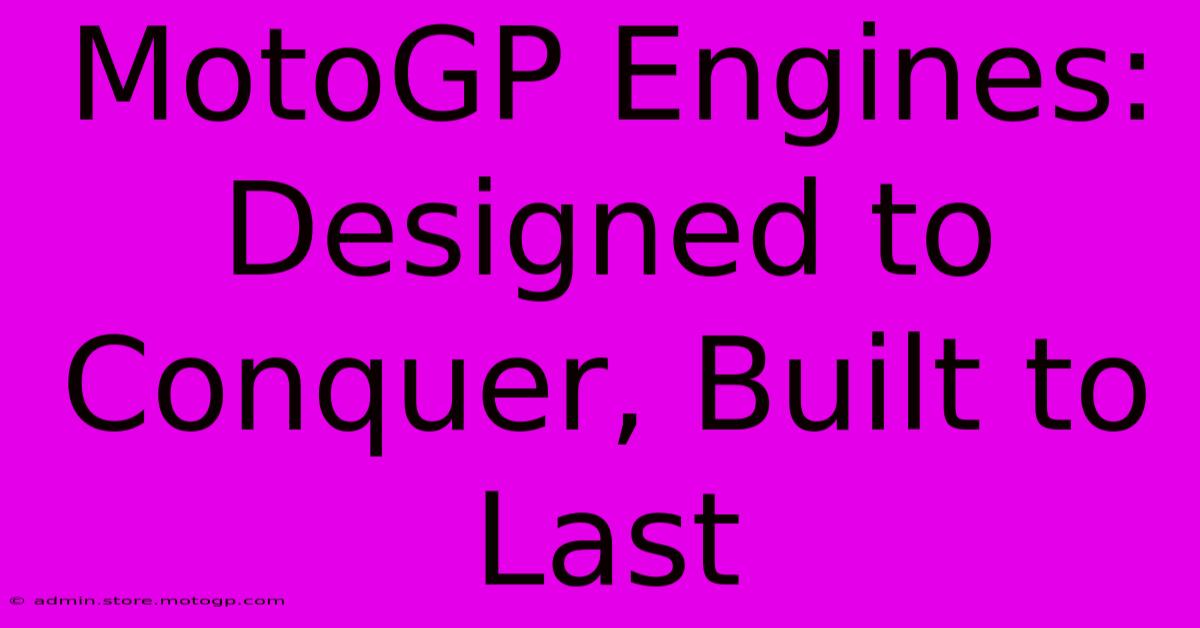MotoGP Engines: Designed To Conquer, Built To Last

Table of Contents
MotoGP Engines: Designed to Conquer, Built to Last
The roar of a MotoGP engine, the shriek of tires on asphalt, the breathtaking speed – these are the hallmarks of the pinnacle of motorcycle racing. But beneath the spectacle lies a marvel of engineering: engines designed not just for speed, but for unparalleled reliability and performance under extreme conditions. This article delves into the intricate world of MotoGP engines, exploring their design, construction, and the relentless pursuit of perfection that drives their development.
The Heart of the Beast: Engine Specifications
MotoGP engines are four-stroke, 1000cc prototypes, representing the cutting edge of internal combustion technology. While specific designs vary slightly between manufacturers (Honda, Yamaha, Ducati, Aprilia, KTM, etc.), several key features unite them:
- High RPM Capability: These engines are engineered to rev exceptionally high, typically exceeding 16,000 RPM, extracting maximum power from the relatively small displacement. This demands incredibly robust internal components.
- Lightweight Construction: Every gram counts in MotoGP. Engines utilize exotic materials like titanium, magnesium, and carbon fiber to minimize weight while maintaining strength.
- Sophisticated Electronics: Modern MotoGP bikes are heavily reliant on sophisticated electronics, including advanced engine management systems (EMS) that control fuel injection, ignition timing, and traction control, optimizing performance and handling.
- Extreme Power Output: These machines produce upwards of 260 horsepower, delivering unparalleled acceleration and top speed. This raw power is meticulously managed to ensure rider control.
- Seamless Gear Shifting: Quick-shifters allow riders to change gears without using the clutch, contributing to faster lap times and improved control.
Key Components and Their Role
Let's delve into some of the critical components that make these engines tick:
- Crankshaft: The heart of the engine, engineered for extreme rotational speeds and immense forces.
- Connecting Rods: These transfer power from the pistons to the crankshaft, requiring exceptional strength and lightweight design.
- Pistons and Cylinders: These components are highly stressed, demanding precision machining and advanced materials like forged aluminum. The cylinder liners are often coated for reduced friction and wear.
- Valvetrain: Precise valve timing is crucial for optimal performance. MotoGP engines often employ pneumatic valve systems, offering exceptional responsiveness.
- Fuel Injection System: Sophisticated fuel injection systems precisely meter fuel delivery, optimizing combustion efficiency and power output.
The Pursuit of Perfection: Development and Testing
The development of a MotoGP engine is a continuous process of refinement. Manufacturers constantly strive to improve horsepower, reduce weight, and enhance reliability. This involves:
- Extensive Simulation and CFD Analysis: Computer-aided design (CAD) and Computational Fluid Dynamics (CFD) play a crucial role in optimizing engine design before any physical prototypes are built.
- Rigorous Testing: Engines undergo countless hours of testing on dynamometers and on the track, pushing them to their limits under extreme conditions.
- Data Analysis: Telemetry data gathered during testing is meticulously analyzed to identify areas for improvement and fine-tune engine settings.
The Future of MotoGP Engines
The future of MotoGP engines promises continued innovation. While the current regulations favor four-stroke engines, research and development into alternative technologies, such as hybrid systems, will likely play a significant role in shaping the future of this exhilarating motorsport. The relentless pursuit of performance, coupled with increasing environmental awareness, will undoubtedly drive the development of even more sophisticated and efficient engines in the years to come.
Conclusion
MotoGP engines are technological masterpieces, representing the pinnacle of internal combustion engine design. Their development is a testament to human ingenuity and the relentless pursuit of pushing boundaries. The combination of raw power, intricate engineering, and cutting-edge technology makes them truly awe-inspiring, captivating both enthusiasts and engineers alike. The roar of these engines represents not just speed, but the relentless drive for innovation and excellence in motorsport.

Thank you for visiting our website wich cover about MotoGP Engines: Designed To Conquer, Built To Last. We hope the information provided has been useful to you. Feel free to contact us if you have any questions or need further assistance. See you next time and dont miss to bookmark.
Featured Posts
-
Witness The Spectacle F1 Concert Vip Experience
Feb 19, 2025
-
Most Moto Gp Wins A Data Driven Perspective
Feb 19, 2025
-
Unleash Your Inner Racer The Moto 3 Bike Guide
Feb 19, 2025
-
Cota Parking Reserve Your Space Now And Relax
Feb 19, 2025
-
F1 Ratings Separating Fact From Fiction
Feb 19, 2025
